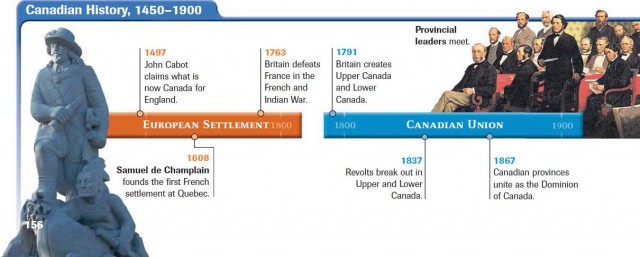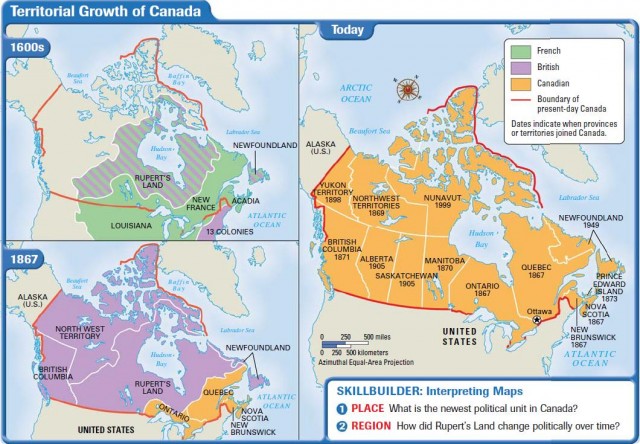History and Government of Canada
A HUMAN PERSPECTIVE Around A.D. 980, a Viking named Erik the Red sailed to Greenland. Soon after, about 3,000 Vikings colonized the region. About A.D. 1000, Erik's son Leif led an expedition that landed off the Atlantic coast of North America on what is now Newfoundland. Leif called the area Vinland, after the wild grapes that grew there. The Vikings built a settlement but later abandoned it. Five centuries would pass before another European, an Italian navigator named Giovanni Caboto, would come to North America. In 1497, exploring for the English, Caboto (John Cabot in English) landed in Newfoundland and claimed the region for England. European exploration and colonization followed.
The First Settlers and Colonial Rivalry
Canada's vast size and its cold climate significantly affected its development. So did the early migrations of people across its land, the bitter territorial rivalry between the two European nations that colonized it— England and France—and their conflict with the First Nations peoples.
EARLY PEOPLES
As you read in Chapter 5, one of the greatest migrations in history took place thousands of years ago, after the last Ice Age.
Migrants from Asia began moving into North America across an Arctic land bridge that connected the two continents. Some early peoples remained in what are now the Canadian Arctic and Alaska. These were the ancestors of the Inuit (or Eskimos). Others, the ancestors of the North American Indian peoples, gradually moved south, into present-day British Columbia and beyond. When the ice melted, they moved throughout Canada. They settled where they could grow crops.
COLONIZATION BY FRANCE AND BRITAIN
During the 16th and 17th centuries, French explorers claimed much of Canada. Their settlements were known as New France. The British, too, were colonizing North America along the Atlantic coast. To both countries, the coastal fisheries and the inland fur trade were important. Soon, the French and British challenged each other's territorial claims. Britain defeated France in the French and Indian War (1754–1763), forcing France to surrender its territory. But French settlers remained.
Steps Toward Unity
By the end of the 18th century, Canada had become a land of two distinct cultures—Roman Catholic French and Protestant English. Conflicts erupted between the two groups, and in 1791, the British government split Canada into two provinces, or political units. Upper Canada (later, Ontario), located near the Great Lakes, had an English-speaking majority, while Lower Canada (Quebec), located along the St. Lawrence River, had a French-speaking population. The land to the northwest, called Rupert's Land, was owned by a British fur-trading company.
ESTABLISHING THE DOMINION OF CANADA
Over the next few decades, Quebec City, Montreal, and Toronto developed as major cities in Canada. Population soared as large numbers of immigrants came from Great Britain. Railways and canals were built, and explorers moved across western lands seeking better fur-trading areas.
The conflicts between English-speaking and French-speaking settlers had not ended, however. By the late 1830s, there were serious political and ethnic disputes in both Upper and Lower Canada. The British government decided that major reform was needed. In 1867, it passed the British North America Act creating the Dominion of Canada. The Dominion was to be a loose confederation, or political union, of Ontario (Upper Canada), Quebec (Lower Canada), and two British colonies on the Atlantic coast—Nova Scotia and New Brunswick. The Dominion had self-government but remained part of the British Empire. Ottawa, in Ontario, became the capital.

As the map above shows, the Dominion grew rapidly. It gained control of Rupert's Land in 1869. By 1871, Canada stretched from the Atlantic to the Pacific, as Manitoba, British Columbia, and Prince Edward Island were added. Soon the Yukon Territory, Alberta, and Saskatchewan followed. Only Newfoundland remained outside the union, not joining until the mid-20th century.

Continental Expansion and Development
With so much area to settle, Canada set about making its land accessible to pioneers. Successful settlement of the west would depend on good transportation routes: roads, canals, and railroads.
FROM THE ATLANTIC TO THE PACIFIC
In 1872, the government began construction of a transcontinental railroad. In 1885, the main line of the railway, from Montreal to Vancouver, was completed. The coasts were now linked by rail. A little more than a decade later, gold was discovered in the Yukon. Fortune-hunters from around the world headed to Canada. Not long after, copper, zinc, and silver deposits also were found in Canada, prompting the building of new railroads and towns. At the same time, immigrants from other parts of Europe besides Britain were coming to Canada's vast open lands. The Dominion was taking on a new character.
URBAN AND INDUSTRIAL GROWTH
For much of the time after settlement, Canadians lived in rural areas and engaged in farming. But as the population grew and natural resources were developed, Canada became more urban and industrial. Cities and towns first sprang up wherever farming was possible.
Later, these same areas became manufacturing and service industry centers, drawing more people to them. Nearly all of this growth took place within 100 miles of the U.S. border. There, the climate was warmer, the land more productive, and transportation linking east and west more widely available.
Like its neighbor to the south, Canada developed into a major economic power in the 20th century.
Governing Canada
Canada was recognized as an independent nation by Britain in 1931. Like Great Britain, Canada has a parliamentary government, a system in which legislative and executive functions are combined in a legislature called a parliament. A central federal government and smaller provincial and territorial governments govern Canada. Although Canada is independent, its symbolic head of state remains the British monarch. Parliament handles all legislative matters. The Parliament consists of an appointed Senate and an elected House of Commons. The majority party's leader in Parliament becomes prime minister, or head of the government. Each of Canada's ten provinces has its own legislature and premier (prime minister). The federal government administers the territories.
In this section, you read about the history and government of Canada. In the next section, you will learn about life in Canada today.